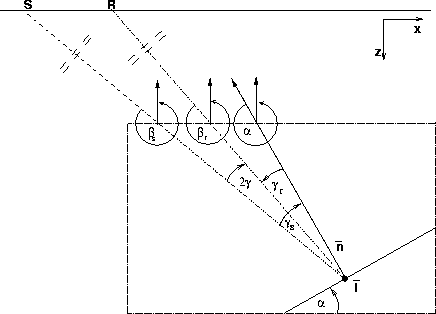![[*]](http://sepwww.stanford.edu/latex2html/cross_ref_motif.gif) illustrates the generalized geometry of
the forward-scattering scenario for a subsurface geologic
discontinuity,
illustrates the generalized geometry of
the forward-scattering scenario for a subsurface geologic
discontinuity, An ODCIG can be transformed to another image-space volume, termed an angle-domain common-image gather (ADCIG), representing reflectivity as a function of reflection angle. Sava and Fomel (2003b) present a post-imaging, Fourier-domain transform between these spaces appropriate for conventional reflection wavefields. However, as discussed by Rosales and Rickett (2001), this transform does not hold for converted waves because Snell's Law partitions the total reflection angle into unequal source- and receiver-side reflection contributions.
Figure ![[*]](http://sepwww.stanford.edu/latex2html/cross_ref_motif.gif) illustrates the generalized geometry of
the forward-scattering scenario for a subsurface geologic
discontinuity,
illustrates the generalized geometry of
the forward-scattering scenario for a subsurface geologic
discontinuity, ![]() , oriented at geologic dip angle,
, oriented at geologic dip angle,
![]() , with normal,
, with normal, ![]() . An upgoing planar source wavefield
propagating at angle
. An upgoing planar source wavefield
propagating at angle ![]() to the upward vertical has already
interacted at
to the upward vertical has already
interacted at ![]() to generate an upgoing, planar
wavefield propagating at angle
to generate an upgoing, planar
wavefield propagating at angle ![]() .
.
 |
For P-P interactions, Snell's Law requires that total reflection opening
angle, ![]() , is split equally between the source- and
receiver-side reflection angles (i.e.,
, is split equally between the source- and
receiver-side reflection angles (i.e., ![]() ). For P-S
conversions, Snell's Law requires that angle
). For P-S
conversions, Snell's Law requires that angle ![]() is not bisected
into equal components, leaving
is not bisected
into equal components, leaving ![]() unequal to
unequal to ![]() . Hence,
additional constraint equations must be included to isolate the
receiver-side reflectivity contributions.
. Hence,
additional constraint equations must be included to isolate the
receiver-side reflectivity contributions.